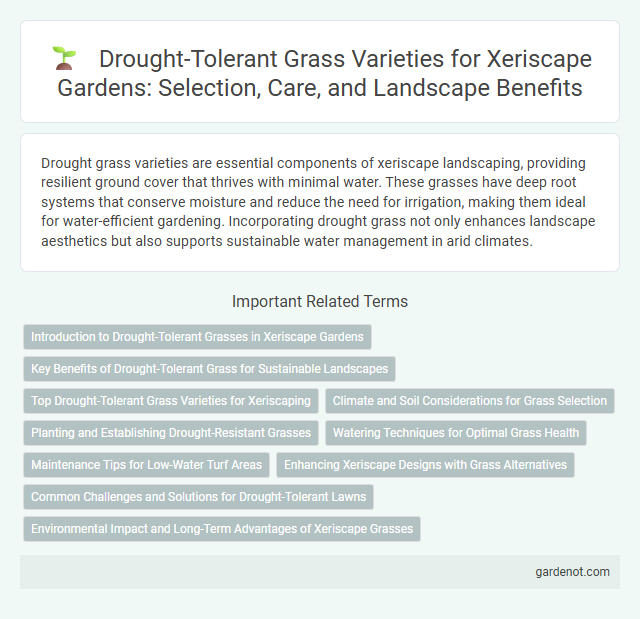Drought grass varieties are essential components of xeriscape landscaping, providing resilient ground cover that thrives with minimal water. These grasses have deep root systems that conserve moisture and reduce the need for irrigation, making them ideal for water-efficient gardening. Incorporating drought grass not only enhances landscape aesthetics but also supports sustainable water management in arid climates.
Introduction to Drought-Tolerant Grasses in Xeriscape Gardens
Drought-tolerant grasses such as Buffalo Grass, Blue Grama, and Bermuda Grass are essential components of xeriscape gardens due to their minimal water requirements and resilience to arid conditions. These grasses have deep root systems that enhance soil stability and improve water infiltration, making them ideal for sustainable landscaping. Incorporating drought grass promotes water conservation while maintaining green space aesthetics in xeriscaping design.
Key Benefits of Drought-Tolerant Grass for Sustainable Landscapes
Drought-tolerant grass significantly reduces water consumption, making it an ideal choice for sustainable landscaping in arid regions. These grasses maintain green coverage and soil stability under limited irrigation, preventing erosion and promoting healthier soil ecosystems. By reducing reliance on frequent watering and chemical fertilizers, drought-tolerant grass supports water conservation and lowers maintenance costs.
Top Drought-Tolerant Grass Varieties for Xeriscaping
Bermuda grass, buffalo grass, and blue grama are top drought-tolerant grass varieties ideal for xeriscaping due to their deep root systems and low water requirements. Zoysia grass and fescues also excel in conserving water while maintaining green coverage in dry climates. These grasses reduce irrigation needs, making them sustainable choices for arid landscapes.
Climate and Soil Considerations for Grass Selection
Drought-resistant grasses thrive in xeriscape designs by adapting to arid climates with minimal rainfall and variable temperatures. Soil types such as sandy, well-drained soils enhance water retention efficiency, supporting grass survival under limited irrigation. Selecting native or warm-season grasses optimized for local climate and soil conditions reduces water usage and maintenance in sustainable landscaping.
Planting and Establishing Drought-Resistant Grasses
Planting drought-resistant grasses involves selecting native or adapted species such as Buffalo grass, Blue grama, or Bermuda grass known for their deep root systems and minimal water requirements. Establishing these grasses requires proper soil preparation, including aeration and the incorporation of organic matter to enhance moisture retention and nutrient availability. Initial watering should be frequent but light, gradually reducing as the grass establishes to encourage deep root growth and long-term drought tolerance.
Watering Techniques for Optimal Grass Health
Drought-tolerant grasses such as buffalo grass and blue grama require deep, infrequent watering to promote robust root development and reduce water usage. Watering early in the morning minimizes evaporation and allows soil to absorb moisture efficiently, enhancing the grass's drought resistance. Implementing soil moisture sensors can optimize irrigation schedules, ensuring grass receives adequate hydration without waste.
Maintenance Tips for Low-Water Turf Areas
Drought grass varieties such as Bermuda, Buffalo, and Zoysia require minimal irrigation, making them ideal for xeriscape turf areas. Maintenance tips include mowing at higher blade heights to promote deeper root growth, reducing water evaporation and improving drought resilience. Regular aeration and periodic overseeding help maintain turf density while minimizing water usage across low-water landscapes.
Enhancing Xeriscape Designs with Grass Alternatives
Drought-tolerant grass alternatives like buffalo grass, blue grama, and fescues enhance xeriscape designs by reducing water consumption and maintenance needs. These grasses thrive in arid conditions, promoting soil health and preventing erosion while maintaining aesthetic appeal. Incorporating native drought-resistant grasses supports local ecosystems and maximizes landscape sustainability.
Common Challenges and Solutions for Drought-Tolerant Lawns
Drought grass varieties, such as Bermuda and Buffalo grass, often face challenges like uneven growth, soil compaction, and nutrient deficiencies in xeriscape lawns. Implementing deep, infrequent watering and aeration improves root development and soil health, while applying slow-release fertilizers addresses nutrient gaps without promoting excessive water use. Selecting drought-tolerant species and maintaining proper mowing height further reduces stress and enhances lawn resilience under arid conditions.
Environmental Impact and Long-Term Advantages of Xeriscape Grasses
Drought-tolerant xeriscape grasses significantly reduce water consumption by thriving with minimal irrigation, easing the strain on freshwater resources. Their deep root systems improve soil health and increase carbon sequestration, helping mitigate climate change effects. Long-term advantages include decreased maintenance costs and enhanced urban biodiversity, contributing to sustainable landscape practices.
Drought grass Infographic

 gardenot.com
gardenot.com